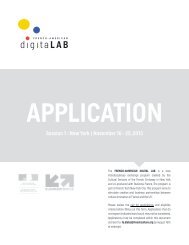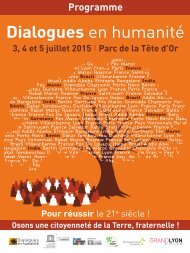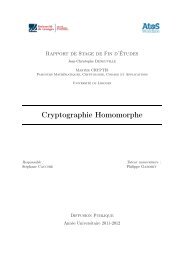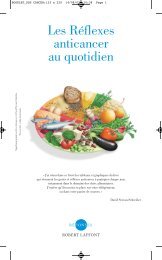REX
BD16_REX
BD16_REX
You also want an ePaper? Increase the reach of your titles
YUMPU automatically turns print PDFs into web optimized ePapers that Google loves.
Retours d’expériences Big Data en entreprise<br />
CHALLENGES<br />
Oxford University Press made a strategic decision to develop its new platform simultaneously with the first product<br />
implemented on it. While this added complexity to the project, the company believed that this approach would accomplish<br />
two goals. First, it would mean that OUP could more quickly realize the fiscal and practical benefits of<br />
the platform. Second and perhaps more importantly, the platform would have a real-world example against which<br />
to test itself.<br />
THE AFRICAN AMERICAN STUDIES CENTER’S REQUIREMENTS<br />
The Oxford African American Studies Center (AASC), edited by Henry Louis Gates, Jr., was developed to be the<br />
online authority on the African American experience. To be the preeminent scholarly reference on African American<br />
studies, the AASC site needed to aggregate and publish a range of content and formats:<br />
• Core content: Five major Oxford encyclopedias covering all aspects of the African American past, including Encyclopedia<br />
Africana (5 vol.) and Black Women in America (3 vol.)<br />
• Additional source content from more than 18 Oxford reference sources, all editorially selected and reviewed<br />
• Approximately 1,000 images at the product launch, with an ongoing image research program expected to add<br />
hundreds more images annually<br />
• 100 primary sources, including the Emancipation Proclamation, Frederick Douglass’s slave<br />
narratives, and text of speeches. Brief introductory essays accompany each primary source.<br />
• More than 200 charts, tables, and graphs representing demographic information in areas like history, government<br />
and politics, business and labor, education, law and crime, and the arts<br />
• Over 140 thematic maps illustrating demographics and history in a variety of areas<br />
• A general timeline of African American history, and specific thematic timelines<br />
• Learning center: Designed for the school market, this will be a growing area that aims to help users explore the<br />
content with ready reference tools like country profiles, suggested lesson plans by grade level, and study guides<br />
to match the curriculum<br />
The AASC needed to support two types of users with different expectations for finding information:<br />
• The primary users would be librarians, who are knowledge professionals. This class of users would demand<br />
complex search functionality, including boolean, proximity, field, thesaurus, stemming, and wildcard.<br />
• Secondary users would be students, who would want simple searching capabilities in the model of Google.<br />
PLATFORM REQUIREMENTS<br />
The two guiding principles for developing the platform, according to Alex Humphreys, OUP’s Director of Online<br />
Engineering, were “flexibility and scalability.” He goes on to say, “These two principles should each be realized in<br />
the areas of content creation and management, product development, and project management.”<br />
TABLE 1: PLATFORM REQUIREMENTS<br />
FLEXIBILITY<br />
SCALABILITY<br />
CONTENT<br />
OUP wanted a model where content could<br />
be created once, and then used in multiple<br />
products. At the same time, the platform<br />
could not define the content format. It<br />
would need to use and integrate content in<br />
a variety of formats, from different sources,<br />
and using different DTDs.<br />
The platform could not place any constraints<br />
on the volume of content that could be supported.<br />
PRODUCT<br />
It was critical that the platform did not dictate<br />
product features or capabilities. Instead,<br />
it needed to be extensible to support<br />
market-driven needs and requirements.<br />
For the platform to be successful, the investment<br />
in features, hardware, and resource<br />
training needed to be leveraged between<br />
products. Each new product could not be a<br />
one-off proposition.<br />
PROJECT<br />
The platform needed to provide multiple<br />
options for integration with other systems<br />
and capabilities. It needed to enable OUP<br />
to work with any number of different vendors,<br />
suiting the vendor selection to the<br />
specific needs of each new project.<br />
The platform needed to provide a foundation<br />
that would enable OUP to work on multiple<br />
projects simultaneously. This meant limiting<br />
its dependence on any one vendor by allowing<br />
multiple vendors to interact with the platform<br />
using a defined API.<br />
To ensure longevity and extensibility of the platform, OUP decided that the platform would need to be standardsbased,<br />
utilizing XML to the greatest extent possible.<br />
Document réalisé par la Société Corp Events - Janvier 2015<br />
51







